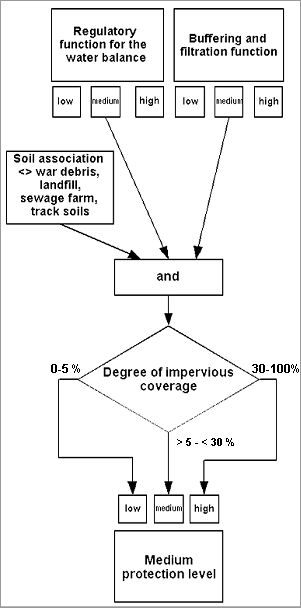Differentiated Assessment of Soil Functions
In order to solve the two tasks of developing a differentiated assessment of soil functions, and implementing this soil-function assessment to create Planning Advices, the following thought processes and work steps have been implemented in Map 01.13:
First of all, the soil functions (Maps 01.12.1 through 01.12.5) have been weighted differently, according to their significance depending on the specific conditions in Berlin (cf. Gerstenberg et al., 2007 and 2015 for more detail):
- It is deemed extremely important to protect soils functioning as archives and soils which constitute potential sites for rare and near-natural plant communities, as these soils cannot be restored.
- In general, it is important to protect soils with a high regulatory function for the water balance and buffering and filtration function. This importance increases further at these locations if both functions occur and are rated as “high”.
It is important to sustain soils with a high yield function for cultivated plants in areas that are used for agriculture.
This establishes a prioritization regarding the importance and vulnerability of soil functions.
Moreover, soils with clear potential for material contamination (e.g. sewage farms) with regard to their regulatory, filtration and buffering functions as well as their yield function for cultivated plants are excluded from the assessment, as they are a potential source of contamination for the groundwater and the food chain.
To assess soils in terms of their level of protection, five protection categories have been established, ranging from the maximum to the lowest protection status. These may be used to derive strategies for action and recommended strategies in the event of soil interventions due to planning and construction projects.
The following soil protection categories are distiniguished to represent the protection level of soils:
- maximum protection level,
- very high protection level,
- high protection level,
- medium protection level and
- low protection level (soils without special requirements).
All information and assessments presented here relate to pervious soils, as is the case for all Environmental Atlas maps covering soil as a topic, with the exception of the map on impervious soil coverage. The extent of impervious coverage is of great importance, however. The degree of impervious coverage is therefore not only presented in the factual data display but is also reflected by different colour shades. There are three different colour shades; with decreasing impervious coverage, the colour intensity of the protection category also decreases.
Five % and 30 % were chosen as thresholds to separate the different levels of impervious coverage: areas with a level of impervious coverage of 5 % or less can be considered completely pervious, interrupted only by scattered buildings, pathways etc. This includes forests, farmland and meadows and pastures. Allotment gardens, single-family homes, park facilities and other open spaces, which may also still have near-natural soils, prevail in the “medium” category with an impervious coverage level of between more than 5 % and less than 30 %. Impervious coverage that is greater than 30 % occurs primarily in residential and commercial areas, and in traffic areas, where no natural soil associations remain to a large extent.










